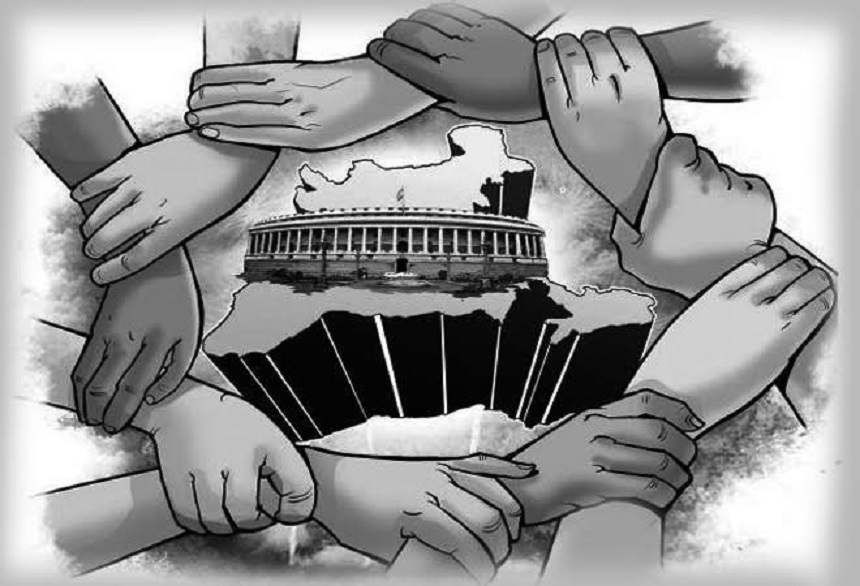
Despite all the criticism that these laws and schemes drew, it appears that the government did not violate Indian federalism. Why else would states accept the jurisdiction of the center in all these matters?
By Haris Rashid
EVER since the current central government led by Narendra Modi came into power in 2014, there have been concerns that the government is sounding a death knell for federalism in India. Certain policies brought by this government have given rise to this concern. These concerns reached a crescendo recently when the Ministry of Home Affairs’ extended the jurisdiction of BSF from 15 Kilometers to 50 Kilometers from the international border. This move brought a large area of border states of Punjab, Assam and West Bengal under center’s jurisdiction and drew harsh criticism from the opposition parties. Before that, the GST regime brought by the Modi government was criticized for its assault on Indian federalism. Besides, the implementation of the “One nation, One ration card” scheme also drew criticism from different opposition ruled states because it went against the idea of federalism. Further, Narendra Modi is often seen advocating “One nation, One election” and “One nation, one voters’ list” under which his government has proposed to hold simultaneous elections across different levels using a single electoral list. Despite all the criticism that these laws and schemes drew, it appears that the government did not violate Indian federalism. Why else would states accept the jurisdiction of the center in all these matters?
Indian federalism is considered sui generis. At the time of constitution-making, there were three competing arguments on the location of power- anti-statists, Gandhi and his supporters, argued for a Village Republic while advocates of centralization, Ambedkar and Nehru, argued for a strong center and others who advocated considerable autonomy for the regional units. It is often claimed that a concentrated authority was preferred in an effort to prevent secession or “Balkanization of India”. However, as Madhav Khosla argues, the “existence of a centralized state involved a turn to modernity” and “to distance power from local actors meant that power could be exercised progressively.” Ambedkar complemented this argument with several examples. He illustrated that the central legislation banning untouchability would find resistance in several regions and it would remain unexecuted if the center does not have its force. Similarly, Ambedkar argued that laws concerning child marriage and labour legislation will remain unexecuted if the centre does not have enough authority. Hence, the founders of the Indian Constitution preferred a strong center in order to ensure compliance of regional units with the laws made by the parliament.
Even though there is formal partitioning of power between the center and regional units and both enjoy exclusive powers of legislation, there are certain features of a unitary state in the Indian Constitution, like- regional units have not been granted independent political identity, they can be territorially altered without their consent by the parliament, unequal representation of states in Upper House, Rajya Sabha, and the existence of strong emergency provisions. Therefore, the framework of the Indian Constitution is not straightforwardly federal. K. C. Wheare refers to this framework as “quasi-federal”.
Although the Indian Constitution is quasi-federal in its framework, the Seventh Schedule of the constitution specifies distribution of power and responsibilities between the state and the center. State legislatures enjoy exclusive jurisdiction over 61 subjects under the State List of the Seventh Schedule of the Constitution of India. Earlier there were 66 subjects under the State List but five subjects were transferred to the Concurrent List by the 42nd Amendment, 1976. Regarding the Concurrent List, both the Union and State legislature can legislate on subjects contained in the list but in case of a conflict between the state and union law on the same subject, Union law prevails over State law.
The concern right now is that a majority (more than half) of the states and the union territories are ruled by the BJP, which is also ruling at the center. This provides little resistance against the central government’s attempts to usurp the rights of the states. Therefore, concerns about the current government at the center trying to create a “unitary state” are genuine because the same party is in power at the center as well in the majority of the states. However, there is hope in the fact that Indian voters differentiate between state and national elections. Rahul Verma argues that the verdict in assembly polls may not indicate the possible results of the Lok Sabha polls or the vice-versa because voters keep different issues in consideration while voting for the assembly elections and the national elections. In the case of assembly elections, regional issues matter more to the voters while in the case of national elections, voters keep national issues in mind.
Views expressed in the article are the author’s own and do not necessarily represent the editorial stance of Kashmir Observer
The author can be reached at [email protected]
Follow this link to join our WhatsApp group: Join Now
Be Part of Quality Journalism |
Quality journalism takes a lot of time, money and hard work to produce and despite all the hardships we still do it. Our reporters and editors are working overtime in Kashmir and beyond to cover what you care about, break big stories, and expose injustices that can change lives. Today more people are reading Kashmir Observer than ever, but only a handful are paying while advertising revenues are falling fast. |
| ACT NOW |
| MONTHLY | Rs 100 | |
| YEARLY | Rs 1000 | |
| LIFETIME | Rs 10000 | |













